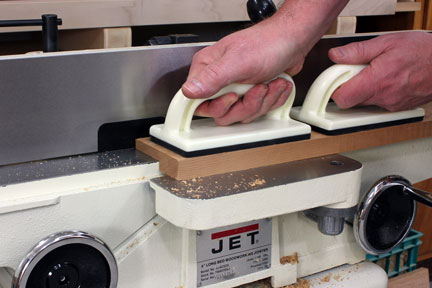
Here is a technical question you may be able to answer. What is a safe optimum rpm for a 3-3/4-in.-diameter jointer cutterhead? This is a belt-driven (3,450 rpm, 1.5hp motor) six-inch jointer. The unit is a restored machine manufactured by H.C. Wood Machinery Works (ca. 1937). – M.W. Tracy
Chris Marshall: Is the jointer connected to that motor now? If so, how well is the machine cutting? If it’s providing smooth faces and edges on your workpieces, then I’d say it is cutting well enough to use. The distance between the little knife-mark scallops in the wood is an indication of how fast the cutterhead is spinning, plus how fast you are feeding the wood over the knives. The closer the scallops, the better. If the scallops are far apart and leaving a ripply surface on the wood, the cutterhead probably isn’t spinning fast enough. But I think you are really asking what should the cutterhead rpm be for that machine, so you can simulate the original H.C. Wood Machinery specs. For that answer, I’d check the chat rooms and websites of vintage tool collectors. Those enthusiasts will probably have the historical information you need to achieve the correct cutterhead speed with a contemporary motor and pulley sizing. I’d start with vintagemachinery.org or Old Wood Working Machines (owwm.org) and see if those folks can help you. Good luck!
Tim Inman: There is no accurate answer I can give you for this question. Short of finding the actual manual from the manufacturer, which might be possible with Internet searches, my best advice would be to follow the lead of current machine makers and use their specs for a similar new machine. The cutterhead sounds pretty “normal” to me, so I think it would be reasonable to use current speeds on new, similar equipment. Be careful, of course. Once you’re ready to go, I would recommend using the 10-foot rule. Get back 10 feet, plug it in with a long cord and see what happens! Our engineers at work often referred to this method as the, “Smoke Test.” Try it out, and if it doesn’t smoke or blow up, then you must be OK. Seriously, be careful, but I think you should be able to get that old machine going again. My jointer is an 8-inch Crescent made in Ohio pre WWI. I rescued it from an old wagon-making factory in Beloit, Wisconsin, in the 1980s. It runs on Babbit bearings, turns at current speeds – and does a great job.





